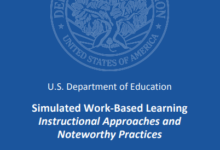Work-based learning, an educational strategy that allows learners to develop technical and employability skills through authentic work experiences, has become a core component of a high-quality Career Technical Education (CTE) program. Yet many states take different approaches to providing work-based learning, each with varying levels of intensity and quality. West Virginia’s Simulated Workplace program demonstrates how states, particularly those in rural geographies, can draw on industry expertise to ensure high-quality work-based learning within a classroom setting.
Simulated Workplace was launched in 2013 after industry leaders expressed a need for students to learn professional skills — such as punctuality, teamwork and maintaining safe work spaces — in addition to the technical skills typically taught in CTE classrooms. Part of the project’s initial success was due to a joint commitment from the state’s workforce development board, Workforce West Virginia — which committed $224,000 in funding and helped promote and evaluate the program — and the West Virginia Chamber of Commerce, which agreed to help mobilize the employer community in the state to get the program off the ground. As a rural state, West Virginia wanted to create a program that opened up access to all communities, including those with limited economic development and activity.
Through Simulated Workplace, students transform their classrooms into business to create an authentic workplace environment. Participants in the program are treated like employees: they are required to pass an interview for entry into the class, fill assigned roles within the company, participate in random drug tests, write a company handbook and pass a safety training.
The program is guided by 12 protocols that the Board of Education adopted to provide structure and consistency across the state. The protocols cover everything from program design and safety to evaluations and accountability, with specific guidance related to each.
One of the more innovative components of the Simulated Workplace protocols is the onsite business review, which brings inspectors from the business community into the classroom to observe and rate programs based on their adherence to industry standards. The evaluation is coordinated by the Department of Education, which recruits employers to visit the classroom as inspectors, schedules site visits, and even provides an Industry Evaluation rubric that inspectors can use to assess Simulated Workplace programs.
For rural school districts without a local industry presence, the Department will occasionally bring business leaders from across the state or connect them to the classroom through web-based video conferencing software. The business review not only contributes to the authenticity of the program, but also helps the Department of Education identify programs in need of improvement. Programs that pass the assessment are deemed “Industry Endorsed Programs.” Those scoring below the threshold are eligible to receive technical support and must develop a program improvement plan.
Policy in Action
After a four-year pilot and roll-out at an increasing number of high schools throughout the state, Simulated Workplace was scaled statewide in 2015. At the same time, the West Virginia Board of Education voted to adopt the 12 Simulated Workplace protocols, which govern the design of the programs and ensure consistency and quality. And in 2018, the board enacted a new policy requiring the Simulated Workplace as a capstone experience for CTE concentrators. Through this rule change, all state-approved CTE programs of study must include a simulated workplace experience to receive state or federal funding. The Simulated Workplace program has grown from 2,252 participants at 20 pilot schools in 2013 to now more than 24,000 students participating in more than 1,300 simulated classrooms throughout the state. Additionally, West Virginia adopted work-based learning as its Perkins V secondary CTE program quality indicator. Learners who participate in the Simulated Workplace model will be counted toward the state’s goal, along with those who participate in more traditional experiences such internships, apprenticeships and clinical work.
The statewide expansion of the Simulated Workplace signals the value West Virginia places on the experience. Building on the success of the Simulated Workplace, the West Virginia Department of Education has started a new pilot program with three middle schools in the state known as Empowerment Academies. This three-year pilot seeks to change traditional processes, protocols and practices through the guiding principles of project-based learning, simulated workplace environments and career exploration.
Resources
- Protocols: Simulated Workplace Protocols
- Manual: Simulated Workplace Operational Manual
- Rubric: Industry Evaluation Rubric
- Webiste: Simulated Workplace website
- Excellence in Action Award Winner, 2014: Rebel Construction Tolsia High School
- Article: New York Times: “Seeing Hope for Flagging Economy, West Virginia Revamps Vocational Track” (2017)
Last Updated June 2021







